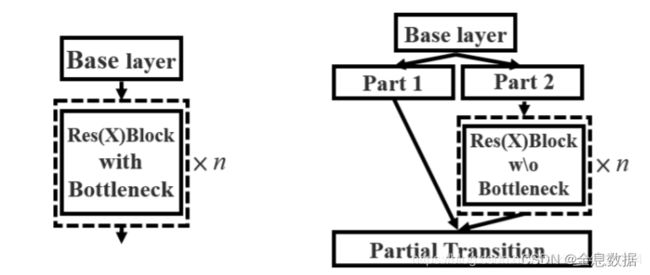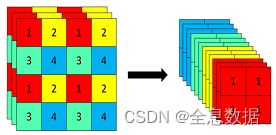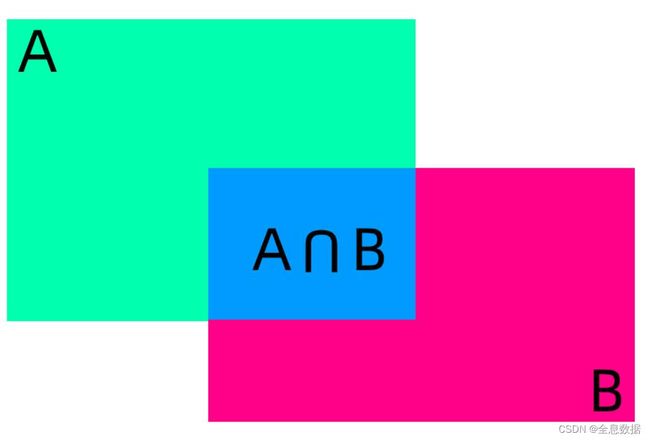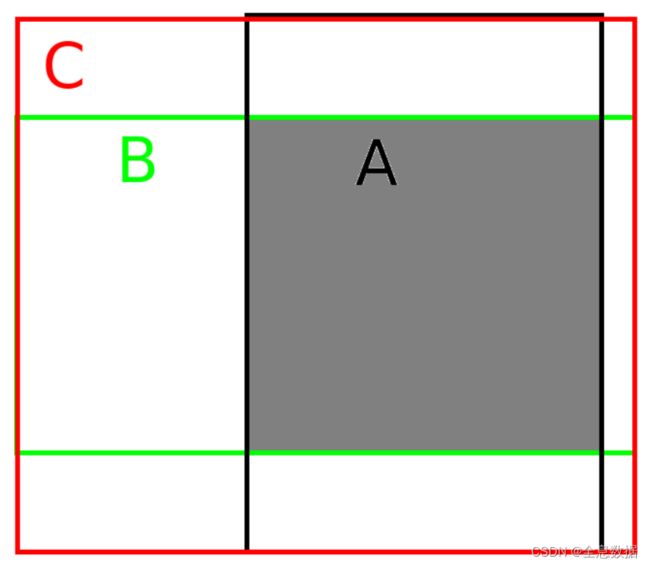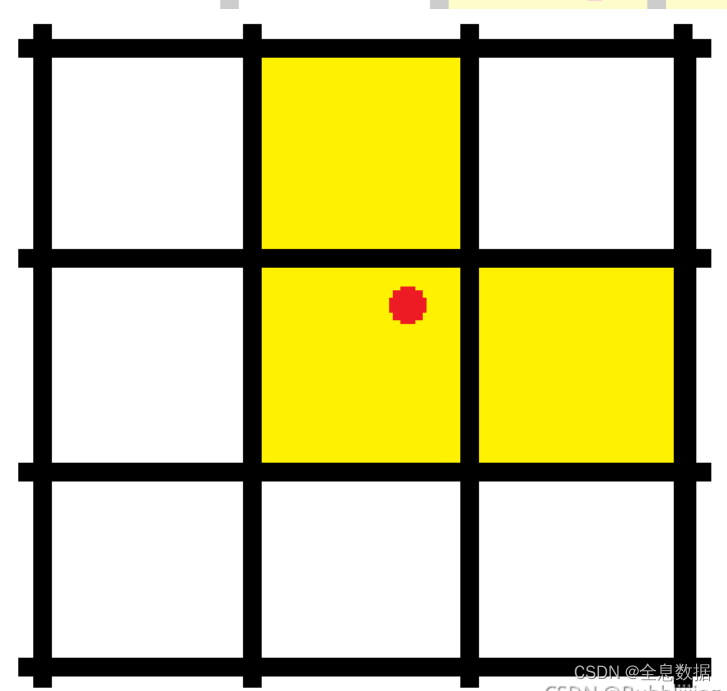YoloV5目标检测系统【详解】
我之前学过yoloV1到yoloV3,但对于图像检测这些明显还不够,所以把yoloV5提上日程,以下是我学习yoloV5的笔记,主要参考此链接。
注:此篇博客非100%原创,主要是学习博客,如侵就删。
文章目录
-
- 一、网络结构
-
- 1、主干网络(backbone)
-
- 1.1 BottleNeck
- 1.2 CSPnet
- 1.3 Focus结构
- 1.4 Silu激活函数
- 1.5 SPP结构
- 1.6 整个主干(backbone)实现代码
- 2、FPN(特征金字塔)
- 3、利用Yolo Head获取预测结果
- 二、预测结果的解码
-
- 1、预测框和先验框(anchor)的解析
- 2、得分筛选与非极大抑制(NMS)
- 三、解析Yolo Loss
-
- 1、IoU
-
- 1.1 GIoU
- 2、Loss的组成
- 3、正样本的匹配过程
YoloV5的网络结构:
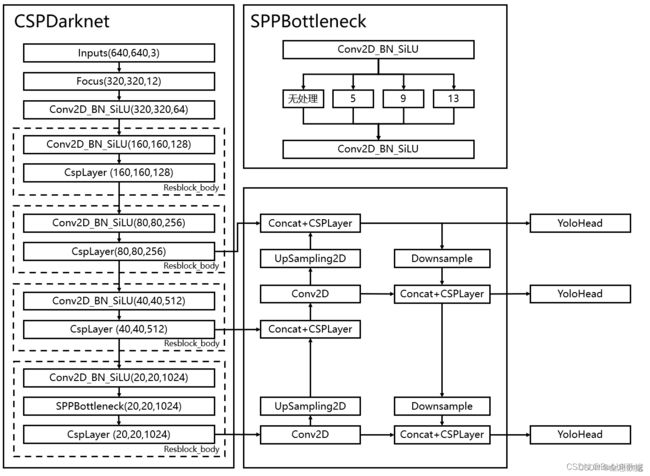
一、网络结构
1、主干网络(backbone)
下面介绍主干网络用到的网络结构
1.1 BottleNeck
作用:
1、结合不同层次的信息,使网络做的更深;
2、残差网络的特点是容易优化,并且能够通过增加相当的深度来提高准确率;
3、其内部的残差块使用了跳跃连接,缓解了在深度神经网络中增加深度带来的梯度消失问题。
import torch
import torch.nn as nn
class Bottleneck(nn.Module):
def __init__(self, c1, c2, e, shortcut=True):
super(Bottleneck, self).__init__()
self.c_ = int(c1 * e) # hidden channels
self.conv1 = nn.Conv2d(c1, self.c_, 1, 1)
self.conv2 = nn.Conv2d(self.c_, c2, 3, 1, 1)
self.add = shortcut and c1 == c2
def forward(self, x):
return x + self.conv2(self.conv1(x)) if self.add else self.conv2(self.conv1(x))
if __name__ == '__main__':
x = torch.randn(2, 3, 3, 3)
print(x.shape)
out = Bottleneck(3, 3, 0.5)(x)
print(out.shape)
输出:
torch.Size([2, 3, 3, 3])
torch.Size([2, 3, 3, 3])
1.2 CSPnet
作用:
1、
过程:
1、输入的feature map先做1×1卷积,然后再进行Bottleneck,得到f1;
2、输入的feature map只做1×1卷积,得到f2;
3、对f1和f2进行堆叠,再进行1×1卷积得到f3;
class CspNet(nn.Module):
def __init__(self, c1, c2, e, n=1):
super(CspNet, self).__init__()
c_ = int(c1 * e)
self.conv1 = nn.Conv2d(c1, c_, 1, 1)
self.conv2 = nn.Conv2d(c1, c_, 1, 1)
self.conv3 = nn.Conv2d(2 * c_, c2, 1, 1)
self.m = nn.Sequential(*[Bottleneck(c_, c_, 0.5) for _ in range(n)])
def forward(self, x):
return self.conv3(torch.cat((self.m(self.conv1(x)), self.conv2(x)), dim=1))
if __name__ == '__main__':
x = torch.randn(2, 5, 3, 3)
print(x.shape)
out = CspNet(5, 5, 0.5)(x)
print(out.shape)
输出:
torch.Size([2, 5, 3, 3])
torch.Size([2, 5, 3, 3])
1.3 Focus结构
定义:
使用了Focus网络结构,这个网络结构是在YoloV5里面使用到比较有趣的网络结构,具体操作是在一张图片中每隔一个像素拿到一个值,这个时候获得了四个独立的特征层,然后将四个独立的特征层进行堆叠,此时宽高信息就集中到了通道信息,输入通道扩充了四倍。拼接起来的特征层相对于原先的三通道变成了十二个通道,下图很好的展示了Focus结构,一看就能明白。
import torch
import torch.nn as nn
class Focus(nn.Module):
def __init__(self, c1, c2):
super(Focus, self).__init__()
self.conv1 = nn.Conv2d(c1 * 4, c2, 1, 1)
def forward(self, x):
return self.conv1(
torch.cat((x[..., ::2, ::2], x[..., ::2, 1::2], x[..., 1::2, ::2], x[..., 1::2, 1::2]), dim=1))
if __name__ == '__main__':
x = torch.randn(2, 3, 4, 4)
print(x.shape)
out = Focus(3, 3)(x)
print(out.shape)
输出:
torch.Size([2, 3, 4, 4])
torch.Size([2, 3, 2, 2])
1.4 Silu激活函数
silu激活函数结合了relu和sigmoid函数,具备无上界有下界、平滑、非单调的特性。SiLU在深层模型上的效果优于 ReLU。可以看做是平滑的ReLU激活函数。
import matplotlib.pyplot as pl
import torch
import torch.nn as nn
import numpy as np
class SiLU(nn.Module):
@staticmethod
def forward(x):
return x * torch.sigmoid(x)
# x=torch.randn(2,3,3,3)
x = np.linspace(-10, 10, 100)
out = SiLU.forward(torch.from_numpy(x))
print(out.shape) # torch.Size([100])
fig = pl.figure()
pl.plot(x, out)
pl.show()
1.5 SPP结构
定义:
使用不同大小的池化核对feature map分别进行池化,然后进行堆叠之后再卷积;
作用:
通过不同大小的池化核进行池化,会提高网络的感受野。在YoloV4中,SPP是用在FPN里面的,在YoloV5中,SPP模块被用在了主干特征提取网络中。
import torch
import torch.nn as nn
class SPP(nn.Module):
def __init__(self, c1, c2, k=[5, 7, 13]):
super(SPP, self).__init__()
c_ = int(c1 // 2) # hidden channel
self.conv1 = nn.Conv2d(c1, c_, 1, 1)
self.conv2 = nn.Conv2d(c_ * (len(k) + 1), c2, 1, 1)
self.m = nn.ModuleList([nn.MaxPool2d(kernel_size=_, stride=1, padding=_ // 2) for _ in k])
def forward(self, x):
x = self.conv1(x)
return self.conv2(torch.cat([x] + [m(x) for m in self.m], dim=1))
if __name__ == '__main__':
x = torch.randn(2, 3, 26, 26)
out = SPP(3, 3)(x)
print(out.shape)
输出:
torch.Size([2, 3, 26, 26])
1.6 整个主干(backbone)实现代码
import torch
import torch.nn as nn
class SiLU(nn.Module):
@staticmethod
def forward(x):
return x * torch.sigmoid(x)
def autopad(k, p=None):
if p is None:
p = k // 2 if isinstance(k, int) else [x // 2 for x in k]
return p
class Focus(nn.Module):
def __init__(self, c1, c2, k=1, s=1, p=None, g=1, act=True): # ch_in, ch_out, kernel, stride, padding, groups
super(Focus, self).__init__()
self.conv = Conv(c1 * 4, c2, k, s, p, g, act)
def forward(self, x):
return self.conv(torch.cat([x[..., ::2, ::2], x[..., 1::2, ::2], x[..., ::2, 1::2], x[..., 1::2, 1::2]], 1))
class Conv(nn.Module):
def __init__(self, c1, c2, k=1, s=1, p=None, g=1, act=True):
super(Conv, self).__init__()
self.conv = nn.Conv2d(c1, c2, k, s, autopad(k, p), groups=g, bias=False)
self.bn = nn.BatchNorm2d(c2, eps=0.001, momentum=0.03)
self.act = SiLU() if act is True else (act if isinstance(act, nn.Module) else nn.Identity())
def forward(self, x):
return self.act(self.bn(self.conv(x)))
def fuseforward(self, x):
return self.act(self.conv(x))
class Bottleneck(nn.Module):
# Standard bottleneck
def __init__(self, c1, c2, shortcut=True, g=1, e=0.5): # ch_in, ch_out, shortcut, groups, expansion
super(Bottleneck, self).__init__()
c_ = int(c2 * e) # hidden channels
self.cv1 = Conv(c1, c_, 1, 1)
self.cv2 = Conv(c_, c2, 3, 1, g=g)
self.add = shortcut and c1 == c2
def forward(self, x):
return x + self.cv2(self.cv1(x)) if self.add else self.cv2(self.cv1(x))
class C3(nn.Module):
# CSP Bottleneck with 3 convolutions
def __init__(self, c1, c2, n=1, shortcut=True, g=1, e=0.5): # ch_in, ch_out, number, shortcut, groups, expansion
super(C3, self).__init__()
c_ = int(c2 * e) # hidden channels
self.cv1 = Conv(c1, c_, 1, 1)
self.cv2 = Conv(c1, c_, 1, 1)
self.cv3 = Conv(2 * c_, c2, 1) # act=FReLU(c2)
self.m = nn.Sequential(*[Bottleneck(c_, c_, shortcut, g, e=1.0) for _ in range(n)])
# self.m = nn.Sequential(*[CrossConv(c_, c_, 3, 1, g, 1.0, shortcut) for _ in range(n)])
def forward(self, x):
return self.cv3(torch.cat((self.m(self.cv1(x)), self.cv2(x)), dim=1))
class SPP(nn.Module):
# Spatial pyramid pooling layer used in YOLOv3-SPP
def __init__(self, c1, c2, k=(5, 9, 13)):
super(SPP, self).__init__()
c_ = c1 // 2 # hidden channels
self.cv1 = Conv(c1, c_, 1, 1)
self.cv2 = Conv(c_ * (len(k) + 1), c2, 1, 1)
self.m = nn.ModuleList([nn.MaxPool2d(kernel_size=x, stride=1, padding=x // 2) for x in k])
def forward(self, x):
x = self.cv1(x)
return self.cv2(torch.cat([x] + [m(x) for m in self.m], 1))
class CSPDarknet(nn.Module):
def __init__(self, base_channels, base_depth):
super().__init__()
# -----------------------------------------------#
# 输入图片是640, 640, 3
# 初始的基本通道是64
# -----------------------------------------------#
# -----------------------------------------------#
# 利用focus网络结构进行特征提取
# 640, 640, 3 -> 320, 320, 12 -> 320, 320, 64
# -----------------------------------------------#
self.stem = Focus(3, base_channels, k=3)
# -----------------------------------------------#
# 完成卷积之后,320, 320, 64 -> 160, 160, 128
# 完成CSPlayer之后,160, 160, 128 -> 160, 160, 128
# -----------------------------------------------#
self.dark2 = nn.Sequential(
Conv(base_channels, base_channels * 2, 3, 2),
C3(base_channels * 2, base_channels * 2, base_depth),
)
# -----------------------------------------------#
# 完成卷积之后,160, 160, 128 -> 80, 80, 256
# 完成CSPlayer之后,80, 80, 256 -> 80, 80, 256
# -----------------------------------------------#
self.dark3 = nn.Sequential(
Conv(base_channels * 2, base_channels * 4, 3, 2),
C3(base_channels * 4, base_channels * 4, base_depth * 3),
)
# -----------------------------------------------#
# 完成卷积之后,80, 80, 256 -> 40, 40, 512
# 完成CSPlayer之后,40, 40, 512 -> 40, 40, 512
# -----------------------------------------------#
self.dark4 = nn.Sequential(
Conv(base_channels * 4, base_channels * 8, 3, 2),
C3(base_channels * 8, base_channels * 8, base_depth * 3),
)
# -----------------------------------------------#
# 完成卷积之后,40, 40, 512 -> 20, 20, 1024
# 完成SPP之后,20, 20, 1024 -> 20, 20, 1024
# 完成CSPlayer之后,20, 20, 1024 -> 20, 20, 1024
# -----------------------------------------------#
self.dark5 = nn.Sequential(
Conv(base_channels * 8, base_channels * 16, 3, 2),
SPP(base_channels * 16, base_channels * 16),
C3(base_channels * 16, base_channels * 16, base_depth, shortcut=False),
)
def forward(self, x):
x = self.stem(x)
x = self.dark2(x)
# -----------------------------------------------#
# dark3的输出为80, 80, 256,是一个有效特征层
# -----------------------------------------------#
x = self.dark3(x)
feat1 = x
# -----------------------------------------------#
# dark4的输出为40, 40, 512,是一个有效特征层
# -----------------------------------------------#
x = self.dark4(x)
feat2 = x
# -----------------------------------------------#
# dark5的输出为20, 20, 1024,是一个有效特征层
# -----------------------------------------------#
x = self.dark5(x)
feat3 = x
return feat1, feat2, feat3
if __name__ == '__main__':
x = torch.randn(2, 3, 640, 640)
out = CSPDarknet(64, 3)(x)
for item in out:
print(item.shape)
输出:
torch.Size([2, 256, 80, 80])
torch.Size([2, 512, 40, 40])
torch.Size([2, 1024, 20, 20])
2、FPN(特征金字塔)
作用:进行加强特征提取
过程:
1、在backbone提取到3个有效特征层,当输入为[2, 3, 640, 640],则3个有效特征层分别为:[2, 256,80, 80],[2, 512, 40, 40],[2, 1024, 20, 20],然后利用这3个有效特征层进行FPN的构建;
2、feat3=(20,20,1024)的特征层进行1次1X1卷积调整通道后获得P5,P5进行上采样UmSampling2d后与feat2=(40,40,512)特征层进行结合,然后使用CSPLayer进行特征提取获得P5_upsample,此时获得的特征层为(40,40,512)。
3、P5_upsample=(40,40,512)的特征层进行1次1X1卷积调整通道后获得P4,P4进行上采样UmSampling2d后与feat1=(80,80,256)特征层进行结合,然后使用CSPLayer进行特征提取P3_out,此时获得的特征层为(80,80,256)。
4、P3_out=(80,80,256)的特征层进行一次3x3卷积进行下采样,下采样后与P4堆叠,然后使用CSPLayer进行特征提取P4_out,此时获得的特征层为(40,40,512)。
5、P4_out=(40,40,512)的特征层进行一次3x3卷积进行下采样,下采样后与P5堆叠,然后使用CSPLayer进行特征提取P5_out,此时获得的特征层为(20,20,1024)。
代码:
假设类别数:80
import torch
import torch.nn as nn
from nets.CSPdarknet import CSPDarknet, C3, Conv
# ---------------------------------------------------#
# yolo_body
# ---------------------------------------------------#
class YoloBody(nn.Module):
def __init__(self, anchors_mask, num_classes, phi):
super(YoloBody, self).__init__()
depth_dict = {'s': 0.33, 'm': 0.67, 'l': 1.00, 'x': 1.33, }
width_dict = {'s': 0.50, 'm': 0.75, 'l': 1.00, 'x': 1.25, }
dep_mul, wid_mul = depth_dict[phi], width_dict[phi]
base_channels = int(wid_mul * 64) # 64
base_depth = max(round(dep_mul * 3), 1) # 3
# -----------------------------------------------#
# 输入图片是640, 640, 3
# 初始的基本通道是64
# -----------------------------------------------#
# ---------------------------------------------------#
# 生成CSPdarknet53的主干模型
# 获得三个有效特征层,他们的shape分别是:
# 80,80,256
# 40,40,512
# 20,20,1024
# ---------------------------------------------------#
self.backbone = CSPDarknet(base_channels, base_depth)
self.upsample = nn.Upsample(scale_factor=2, mode="nearest")
self.conv_for_feat3 = Conv(base_channels * 16, base_channels * 8, 1, 1)
self.conv3_for_upsample1 = C3(base_channels * 16, base_channels * 8, base_depth, shortcut=False)
self.conv_for_feat2 = Conv(base_channels * 8, base_channels * 4, 1, 1)
self.conv3_for_upsample2 = C3(base_channels * 8, base_channels * 4, base_depth, shortcut=False)
self.down_sample1 = Conv(base_channels * 4, base_channels * 4, 3, 2)
self.conv3_for_downsample1 = C3(base_channels * 8, base_channels * 8, base_depth, shortcut=False)
self.down_sample2 = Conv(base_channels * 8, base_channels * 8, 3, 2)
self.conv3_for_downsample2 = C3(base_channels * 16, base_channels * 16, base_depth, shortcut=False)
self.yolo_head_P3 = nn.Conv2d(base_channels * 4, len(anchors_mask[2]) * (5 + num_classes), 1)
self.yolo_head_P4 = nn.Conv2d(base_channels * 8, len(anchors_mask[1]) * (5 + num_classes), 1)
self.yolo_head_P5 = nn.Conv2d(base_channels * 16, len(anchors_mask[0]) * (5 + num_classes), 1)
def forward(self, x):
# backbone
feat1, feat2, feat3 = self.backbone(x)
P5 = self.conv_for_feat3(feat3)
P5_upsample = self.upsample(P5)
P4 = torch.cat([P5_upsample, feat2], 1)
P4 = self.conv3_for_upsample1(P4)
P4 = self.conv_for_feat2(P4)
P4_upsample = self.upsample(P4)
P3 = torch.cat([P4_upsample, feat1], 1)
P3 = self.conv3_for_upsample2(P3)
P3_downsample = self.down_sample1(P3)
P4 = torch.cat([P3_downsample, P4], 1)
P4 = self.conv3_for_downsample1(P4)
P4_downsample = self.down_sample2(P4)
P5 = torch.cat([P4_downsample, P5], 1)
P5 = self.conv3_for_downsample2(P5)
# ---------------------------------------------------#
# 第三个特征层
# y3=(batch_size,75,80,80)
# ---------------------------------------------------#
out2 = self.yolo_head_P3(P3)
# ---------------------------------------------------#
# 第二个特征层
# y2=(batch_size,75,40,40)
# ---------------------------------------------------#
out1 = self.yolo_head_P4(P4)
# ---------------------------------------------------#
# 第一个特征层
# y1=(batch_size,75,20,20)
# ---------------------------------------------------#
out0 = self.yolo_head_P5(P5)
return out0, out1, out2
if __name__ == '__main__':
x = torch.randn(2, 3, 640, 640)
out = YoloBody([[1, 2, 3], [4, 5, 6], [7, 8, 9]], 80, "l")(x)
for item in out:
print(item.shape)
输出:
torch.Size([2, 255, 20, 20])
torch.Size([2, 255, 40, 40])
torch.Size([2, 255, 80, 80])
3、利用Yolo Head获取预测结果
下面复制于原链接:
利用FPN特征金字塔,我们可以获得三个加强特征,这三个加强特征的shape分别为(20,20,1024)、(40,40,512)、(80,80,256),然后我们利用这三个shape的特征层传入Yolo Head获得预测结果。
对于每一个特征层,我们可以获得利用一个卷积调整通道数,最终的通道数和需要区分的种类个数相关,在YoloV5里,每一个特征层上每一个特征点存在3个先验框。
如果使用的是voc训练集,类则为20种,最后的维度应该为75 = 3x25,三个特征层的shape为(20,20,75),(40,40,75),(80,80,75)。
最后的75可以拆分成3个25,对应3个先验框的25个参数,25可以拆分成4+1+20。
前4个参数用于判断每一个特征点的回归参数,回归参数调整后可以获得预测框;
第5个参数用于判断每一个特征点是否包含物体;
最后20个参数用于判断每一个特征点所包含的物体种类。
如果使用的是coco训练集,类则为80种,最后的维度应该为255 = 3x85,三个特征层的shape为(20,20,255),(40,40,255),(80,80,255)
最后的255可以拆分成3个85,对应3个先验框的85个参数,85可以拆分成4+1+80。
前4个参数用于判断每一个特征点的回归参数,回归参数调整后可以获得预测框;
第5个参数用于判断每一个特征点是否包含物体;
最后80个参数用于判断每一个特征点所包含的物体种类。
代码同上。
二、预测结果的解码
1、预测框和先验框(anchor)的解析
以下是摘录于原博客:
由第二步我们可以获得三个特征层的预测结果,shape分别为(N,20,20,255),(N,40,40,255),(N,80,80,255)的数据。
但是这个预测结果并不对应着最终的预测框在图片上的位置,还需要解码才可以完成。在YoloV5里,每一个特征层上每一个特征点存在3个先验框。
每个特征层最后的255可以拆分成3个85,对应3个先验框的85个参数,我们先将其reshape一下,其结果为(N,20,20,3,85),(N,40.40,3,85),(N,80,80,3,85)。
其中的85可以拆分成4+1+80。
前4个参数用于判断每一个特征点的回归参数,回归参数调整后可以获得预测框;
第5个参数用于判断每一个特征点是否包含物体;
最后80个参数用于判断每一个特征点所包含的物体种类。
以(N,20,20,3,85)这个特征层为例,该特征层相当于将图像划分成20x20个特征点,如果某个特征点落在物体的对应框内,就用于预测该物体。
如图所示,蓝色的点为20x20的特征点,此时我们对左图黑色点的三个先验框进行解码操作演示:
1、进行中心预测点的计算,利用Regression预测结果前两个序号的内容对特征点的三个先验框中心坐标进行偏移,偏移后是右图红色的三个点;
2、进行预测框宽高的计算,利用Regression预测结果后两个序号的内容求指数后获得预测框的宽高;
3、此时获得的预测框就可以绘制在图片上了。
这是我的理解:
decode_box()就是把yolo head得出的3个feature map进行进一步的处理,如果设定batch-size为2,类别数为80,则输出的3个feature map为torch.Size([2, 255, 20, 20]),torch.Size([2, 255, 40, 40]),torch.Size([2, 255, 80, 80]),经过对feature map的reshape调整shape为:torch.Size([2, 3,20, 20, 85]),torch.Size([2, 3,40, 40, 85]),torch.Size([2, 3,80, 80, 85]),最后一个85维分别是:前4维是预测框的下x, y, w, h,第5维是预测框的置信度,第6维到第85维是类别80类。
然后对前4维进行调整,详见代码,调整后的框即为我们预测的框。
最后对我们预测的框进行归一化,再和置信度、种类进行堆叠之后的shape为:torch.Size([2, 3*20,*20, 85]),然后将堆叠后的feature map传给non_max_suppression()。
代码:
下面的代码我费了好长时间才看懂,这个链接有助于看懂下面的代码
关于调整anchor_w 和anchor_h的size,请先看一下这段代码,很详细,应该能看懂
import numpy as np
import torch
anchors = np.array([[116, 90], [156, 198], [373, 326], [30, 61], [62, 45], [59, 119], [10, 13], [16, 30], [33, 23]])
print(anchors.shape)
anchors_mask = [[6, 7, 8], [3, 4, 5], [0, 1, 2]]
scaled_anchors = [(anchor_width / 32, anchor_height / 32) for anchor_width, anchor_height in
anchors[anchors_mask[2]]]
print(scaled_anchors)
print(torch.FloatTensor(scaled_anchors))
print(torch.FloatTensor(scaled_anchors).shape)
# 输出:
(9, 2)
[(3.625, 2.8125), (4.875, 6.1875), (11.65625, 10.1875)]
tensor([[ 3.6250, 2.8125],
[ 4.8750, 6.1875],
[11.6562, 10.1875]])
torch.Size([3, 2])
------------------------------------
batch_size=2
input_height=input_width=20
anchor_w = torch.FloatTensor(scaled_anchors).index_select(1, torch.LongTensor([0])) # 取出anchor的width
anchor_h = torch.FloatTensor(scaled_anchors).index_select(1, torch.LongTensor([1])) # 取出anchor的high
print(anchor_w)
print(anchor_h)
# 输出:
tensor([[ 3.6250],
[ 4.8750],
[11.6562]])
tensor([[ 2.8125],
[ 6.1875],
[10.1875]])
-------------------------------------
anchor_w = anchor_w.repeat(batch_size, 1)
print(anchor_w)
print(anchor_w.shape)
# 输出:
tensor([[ 3.6250],
[ 4.8750],
[11.6562],
[ 3.6250],
[ 4.8750],
[11.6562]])
torch.Size([6, 1])
----------------------------------------
anchor_w=anchor_w.repeat(1, 1, input_height * input_width)
print(anchor_w)
print(anchor_w.shape)
# 输出:
tensor([[[ 3.6250, 3.6250, 3.6250, ..., 3.6250, 3.6250, 3.6250],
[ 4.8750, 4.8750, 4.8750, ..., 4.8750, 4.8750, 4.8750],
[11.6562, 11.6562, 11.6562, ..., 11.6562, 11.6562, 11.6562],
[ 3.6250, 3.6250, 3.6250, ..., 3.6250, 3.6250, 3.6250],
[ 4.8750, 4.8750, 4.8750, ..., 4.8750, 4.8750, 4.8750],
[11.6562, 11.6562, 11.6562, ..., 11.6562, 11.6562, 11.6562]]])
torch.Size([1, 6, 400])
---------------------------------------------
anchor_w=anchor_w.view([2,3,20,20])
print(anchor_w)
print(anchor_w.shape)
# 输出:
tensor([[[[ 3.6250, 3.6250, 3.6250, ..., 3.6250, 3.6250, 3.6250],
[ 3.6250, 3.6250, 3.6250, ..., 3.6250, 3.6250, 3.6250],
[ 3.6250, 3.6250, 3.6250, ..., 3.6250, 3.6250, 3.6250],
...,
[ 3.6250, 3.6250, 3.6250, ..., 3.6250, 3.6250, 3.6250],
[ 3.6250, 3.6250, 3.6250, ..., 3.6250, 3.6250, 3.6250],
[ 3.6250, 3.6250, 3.6250, ..., 3.6250, 3.6250, 3.6250]],
[[ 4.8750, 4.8750, 4.8750, ..., 4.8750, 4.8750, 4.8750],
[ 4.8750, 4.8750, 4.8750, ..., 4.8750, 4.8750, 4.8750],
[ 4.8750, 4.8750, 4.8750, ..., 4.8750, 4.8750, 4.8750],
...,
[ 4.8750, 4.8750, 4.8750, ..., 4.8750, 4.8750, 4.8750],
[ 4.8750, 4.8750, 4.8750, ..., 4.8750, 4.8750, 4.8750],
[ 4.8750, 4.8750, 4.8750, ..., 4.8750, 4.8750, 4.8750]],
[[11.6562, 11.6562, 11.6562, ..., 11.6562, 11.6562, 11.6562],
[11.6562, 11.6562, 11.6562, ..., 11.6562, 11.6562, 11.6562],
[11.6562, 11.6562, 11.6562, ..., 11.6562, 11.6562, 11.6562],
...,
[11.6562, 11.6562, 11.6562, ..., 11.6562, 11.6562, 11.6562],
[11.6562, 11.6562, 11.6562, ..., 11.6562, 11.6562, 11.6562],
[11.6562, 11.6562, 11.6562, ..., 11.6562, 11.6562, 11.6562]]],
[[[ 3.6250, 3.6250, 3.6250, ..., 3.6250, 3.6250, 3.6250],
[ 3.6250, 3.6250, 3.6250, ..., 3.6250, 3.6250, 3.6250],
[ 3.6250, 3.6250, 3.6250, ..., 3.6250, 3.6250, 3.6250],
...,
[ 3.6250, 3.6250, 3.6250, ..., 3.6250, 3.6250, 3.6250],
[ 3.6250, 3.6250, 3.6250, ..., 3.6250, 3.6250, 3.6250],
[ 3.6250, 3.6250, 3.6250, ..., 3.6250, 3.6250, 3.6250]],
[[ 4.8750, 4.8750, 4.8750, ..., 4.8750, 4.8750, 4.8750],
[ 4.8750, 4.8750, 4.8750, ..., 4.8750, 4.8750, 4.8750],
[ 4.8750, 4.8750, 4.8750, ..., 4.8750, 4.8750, 4.8750],
...,
[ 4.8750, 4.8750, 4.8750, ..., 4.8750, 4.8750, 4.8750],
[ 4.8750, 4.8750, 4.8750, ..., 4.8750, 4.8750, 4.8750],
[ 4.8750, 4.8750, 4.8750, ..., 4.8750, 4.8750, 4.8750]],
[[11.6562, 11.6562, 11.6562, ..., 11.6562, 11.6562, 11.6562],
[11.6562, 11.6562, 11.6562, ..., 11.6562, 11.6562, 11.6562],
[11.6562, 11.6562, 11.6562, ..., 11.6562, 11.6562, 11.6562],
...,
[11.6562, 11.6562, 11.6562, ..., 11.6562, 11.6562, 11.6562],
[11.6562, 11.6562, 11.6562, ..., 11.6562, 11.6562, 11.6562],
[11.6562, 11.6562, 11.6562, ..., 11.6562, 11.6562, 11.6562]]]])
torch.Size([2, 3, 20, 20])
def decode_box(self, inputs):
outputs = []
for i, input in enumerate(inputs):
# -----------------------------------------------#
# 输入的input一共有三个,他们的shape分别是
# batch_size = 1
# batch_size, 3 * (4 + 1 + 80), 20, 20
# batch_size, 255, 40, 40
# batch_size, 255, 80, 80
# -----------------------------------------------#
batch_size = input.size(0)
input_height = input.size(2)
input_width = input.size(3)
# -----------------------------------------------#
# 输入为640x640时
# stride_h = stride_w = 32、16、8
# -----------------------------------------------#
stride_h = self.input_shape[0] / input_height
stride_w = self.input_shape[1] / input_width
# -------------------------------------------------#
# 此时获得的scaled_anchors大小是相对于特征层的
# scaled_anchors.shape:torch.Size([3, 2])
# -------------------------------------------------#
scaled_anchors = [(anchor_width / stride_w, anchor_height / stride_h) for anchor_width, anchor_height in
self.anchors[self.anchors_mask[i]]]
# -----------------------------------------------#
# 输入的input一共有三个,他们的shape分别是
# batch_size, 3, 20, 20, 85
# batch_size, 3, 40, 40, 85
# batch_size, 3, 80, 80, 85
# -----------------------------------------------#
prediction = input.view(batch_size, len(self.anchors_mask[i]),
self.bbox_attrs, input_height, input_width).permute(0, 1, 3, 4, 2).contiguous()
# -----------------------------------------------#
# 先验框的中心位置的调整参数
# -----------------------------------------------#
x = torch.sigmoid(prediction[..., 0]) # shape:torch.Size([b-s, 3, 20, 20])
y = torch.sigmoid(prediction[..., 1])
# -----------------------------------------------#
# 先验框的宽高调整参数
# -----------------------------------------------#
w = torch.sigmoid(prediction[..., 2])
h = torch.sigmoid(prediction[..., 3])
# -----------------------------------------------#
# 获得置信度,是否有物体
# -----------------------------------------------#
conf = torch.sigmoid(prediction[..., 4])
# -----------------------------------------------#
# 种类置信度
# -----------------------------------------------#
pred_cls = torch.sigmoid(prediction[..., 5:]) # shape:torch.Size([b-s, 3, 20, 20, 80])
FloatTensor = torch.cuda.FloatTensor if x.is_cuda else torch.FloatTensor
LongTensor = torch.cuda.LongTensor if x.is_cuda else torch.LongTensor
# ----------------------------------------------------------#
# 生成网格,先验框中心,网格左上角
# batch_size,3,20,20
# ----------------------------------------------------------#
grid_x = torch.linspace(0, input_width - 1, input_width).repeat(input_height, 1).repeat(
batch_size * len(self.anchors_mask[i]), 1, 1).view(x.shape).type(FloatTensor)
grid_y = torch.linspace(0, input_height - 1, input_height).repeat(input_width, 1).t().repeat(
batch_size * len(self.anchors_mask[i]), 1, 1).view(y.shape).type(FloatTensor)
# ----------------------------------------------------------#
# 按照网格格式生成先验框的宽高
# batch_size,3,20,20
# ----------------------------------------------------------#
anchor_w = FloatTensor(scaled_anchors).index_select(1, LongTensor([0]))
anchor_h = FloatTensor(scaled_anchors).index_select(1, LongTensor([1]))
anchor_w = anchor_w.repeat(batch_size, 1).repeat(1, 1, input_height * input_width).view(w.shape)
anchor_h = anchor_h.repeat(batch_size, 1).repeat(1, 1, input_height * input_width).view(h.shape)
# ----------------------------------------------------------#
# 利用预测结果对先验框进行调整
# 首先调整先验框的中心,从先验框中心向右下角偏移
# 再调整先验框的宽高。
# x 0 ~ 1 => 0 ~ 2 => -0.5, 1.5 => 负责一定范围的目标的预测
# y 0 ~ 1 => 0 ~ 2 => -0.5, 1.5 => 负责一定范围的目标的预测
# w 0 ~ 1 => 0 ~ 2 => 0 ~ 4 => 先验框的宽高调节范围为0~4倍
# h 0 ~ 1 => 0 ~ 2 => 0 ~ 4 => 先验框的宽高调节范围为0~4倍
# ----------------------------------------------------------#
pred_boxes = FloatTensor(prediction[..., :4].shape)
pred_boxes[..., 0] = x.data * 2. - 0.5 + grid_x
pred_boxes[..., 1] = y.data * 2. - 0.5 + grid_y
pred_boxes[..., 2] = (w.data * 2) ** 2 * anchor_w
pred_boxes[..., 3] = (h.data * 2) ** 2 * anchor_h
# ----------------------------------------------------------#
# 将输出结果归一化成小数的形式
# output的shape:torch.Size([b-s, 3*20*20, 85])
# ----------------------------------------------------------#
_scale = torch.Tensor([input_width, input_height, input_width, input_height]).type(FloatTensor)
output = torch.cat((pred_boxes.view(batch_size, -1, 4) / _scale,
conf.view(batch_size, -1, 1), pred_cls.view(batch_size, -1, self.num_classes)), -1)
outputs.append(output.data)
return outputs
2、得分筛选与非极大抑制(NMS)
前面的 预测框和先验框(anchor)的解析 已经得到我们预测的所有框,得分筛选与非极大抑制(NMS)对所有框进行筛选。
下面2个图是没有进行NMS的预测框和有NMS的预测框,摘自链接博客;
下面这段摘录于链接博客:
得到最终的预测结果后还要进行得分排序与非极大抑制筛选。
得分筛选就是筛选出得分满足confidence置信度的预测框。 非极大抑制就是筛选出一定区域内属于同一种类得分最大的框。
得分筛选与非极大抑制的过程可以概括如下:
1、找出该图片中得分大于门限函数的框。在进行重合框筛选前就进行得分的筛选可以大幅度减少框的数量。
2、对种类进行循环,非极大抑制的作用是筛选出一定区域内属于同一种类得分最大的框,对种类进行循环可以帮助我们对每一个类分别进行非极大抑制。
3、根据得分对该种类进行从大到小排序。
4、每次取出得分最大的框,计算其与其它所有预测框的重合程度,重合程度过大的则剔除。
得分筛选与非极大抑制后的结果就可以用于绘制预测框了。
下面是得分筛选与非极大抑制(NMS)的过程:
1、首先对所有的预测框进行坐标的调整,从中心宽高格式调整为左上和右下坐标格式;
2、然后对每一个图片进行遍历,通过torch.max函数得到每一个预测框的预测种类和及其种类置信度;然后再对每一个预测框预测的种类和种类置信度进行筛选,不满足条件的将被删去;
3、筛选过后的预测框的 (x1, y1, x2, y2, conf, obj_conf, class_conf, class_pred)组合成新的张量detections;
4、取出上面的detections的种类,并去重;
5、对每一个种类进行循环,先挑选出detections中所有属于同一个种类的张量,并命名为detections_class,然后根据预测框的置信度和种类置信度进行从大到小的排序,最大的当然就是最佳的预测框,并添加(append)到max_detections列表里,然后计算属于同一种类的预测框和最佳预测框的IOU,如果IOU>nms_thres将被删去,即同一区域下的预测框被删去;
6、剩下的不在同一区域的同种类的预测框detections_class得以继续保留,然后再把保留的最佳预测框添加到max_detections,继续第5步骤,直到detections_class为0;
def bbox_iou(self, box1, box2, x1y1x2y2=True):
"""
计算IOU
"""
if not x1y1x2y2:
b1_x1, b1_x2 = box1[:, 0] - box1[:, 2] / 2, box1[:, 0] + box1[:, 2] / 2
b1_y1, b1_y2 = box1[:, 1] - box1[:, 3] / 2, box1[:, 1] + box1[:, 3] / 2
b2_x1, b2_x2 = box2[:, 0] - box2[:, 2] / 2, box2[:, 0] + box2[:, 2] / 2
b2_y1, b2_y2 = box2[:, 1] - box2[:, 3] / 2, box2[:, 1] + box2[:, 3] / 2
else:
b1_x1, b1_y1, b1_x2, b1_y2 = box1[:, 0], box1[:, 1], box1[:, 2], box1[:, 3]
b2_x1, b2_y1, b2_x2, b2_y2 = box2[:, 0], box2[:, 1], box2[:, 2], box2[:, 3]
inter_rect_x1 = torch.max(b1_x1, b2_x1)
inter_rect_y1 = torch.max(b1_y1, b2_y1)
inter_rect_x2 = torch.min(b1_x2, b2_x2)
inter_rect_y2 = torch.min(b1_y2, b2_y2)
inter_area = torch.clamp(inter_rect_x2 - inter_rect_x1, min=0) * \
torch.clamp(inter_rect_y2 - inter_rect_y1, min=0)
b1_area = (b1_x2 - b1_x1) * (b1_y2 - b1_y1)
b2_area = (b2_x2 - b2_x1) * (b2_y2 - b2_y1)
iou = inter_area / torch.clamp(b1_area + b2_area - inter_area, min=1e-6)
return iou
def non_max_suppression(self, prediction, num_classes, input_shape, image_shape, letterbox_image, conf_thres=0.5,
nms_thres=0.4):
# ----------------------------------------------------------#
# 将预测结果的格式转换成左上角右下角的格式。
# prediction [batch_size, num_anchors, 85]
# ----------------------------------------------------------#
box_corner = prediction.new(prediction.shape)
box_corner[:, :, 0] = prediction[:, :, 0] - prediction[:, :, 2] / 2
box_corner[:, :, 1] = prediction[:, :, 1] - prediction[:, :, 3] / 2
box_corner[:, :, 2] = prediction[:, :, 0] + prediction[:, :, 2] / 2
box_corner[:, :, 3] = prediction[:, :, 1] + prediction[:, :, 3] / 2
prediction[:, :, :4] = box_corner[:, :, :4]
output = [None for _ in range(len(prediction))]
for i, image_pred in enumerate(prediction):
# ----------------------------------------------------------#
# 对种类预测部分取max。
# class_conf [num_anchors, 1] 种类置信度
# class_pred [num_anchors, 1] 种类
# ----------------------------------------------------------#
class_conf, class_pred = torch.max(image_pred[:, 5:5 + num_classes], 1, keepdim=True)
# ----------------------------------------------------------#
# 利用置信度进行第一轮筛选
# ----------------------------------------------------------#
conf_mask = (image_pred[:, 4] * class_conf[:, 0] >= conf_thres).squeeze()
# ----------------------------------------------------------#
# 根据置信度进行预测结果的筛选
# ----------------------------------------------------------#
image_pred = image_pred[conf_mask]
class_conf = class_conf[conf_mask]
class_pred = class_pred[conf_mask]
if not image_pred.size(0):
continue
# -------------------------------------------------------------------------#
# detections [num_anchors, 7]
# 7的内容为:x1, y1, x2, y2, obj_conf, class_conf, class_pred
# -------------------------------------------------------------------------#
detections = torch.cat((image_pred[:, :5], class_conf.float(), class_pred.float()), 1)
# ------------------------------------------#
# 获得预测结果中包含的所有种类
# ------------------------------------------#
unique_labels = detections[:, -1].cpu().unique()
if prediction.is_cuda:
unique_labels = unique_labels.cuda()
detections = detections.cuda()
for c in unique_labels:
# ------------------------------------------#
# 获得某一类得分筛选后全部的预测结果
# ------------------------------------------#
detections_class = detections[detections[:, -1] == c]
# #------------------------------------------#
# # 使用官方自带的非极大抑制会速度更快一些!
# #------------------------------------------#
# keep = nms(
# detections_class[:, :4],
# detections_class[:, 4] * detections_class[:, 5],
# nms_thres
# )
# max_detections = detections_class[keep]
# 按照存在物体的置信度排序
_, conf_sort_index = torch.sort(detections_class[:, 4] * detections_class[:, 5], descending=True)
detections_class = detections_class[conf_sort_index]
# 进行非极大抑制
max_detections = []
while detections_class.size(0):
# 取出这一类置信度最高的,一步一步往下判断,判断重合程度是否大于nms_thres,如果是则去除掉
max_detections.append(detections_class[0].unsqueeze(0))
if len(detections_class) == 1:
break
ious = self.bbox_iou(max_detections[-1], detections_class[1:])
detections_class = detections_class[1:][ious < nms_thres]
# 堆叠
max_detections = torch.cat(max_detections).data
# Add max detections to outputs
output[i] = max_detections if output[i] is None else torch.cat((output[i], max_detections))
if output[i] is not None:
output[i] = output[i].cpu().numpy()
box_xy, box_wh = (output[i][:, 0:2] + output[i][:, 2:4]) / 2, output[i][:, 2:4] - output[i][:, 0:2]
output[i][:, :4] = self.yolo_correct_boxes(box_xy, box_wh, input_shape, image_shape, letterbox_image)
return output
三、解析Yolo Loss
1、IoU
定义:IoU就是预测框与真实框的交集面积与并集面积之比,即(预测框与真实框的交集面积)/(预测框与真实框的并集面积)
import torch
def IoU(b1, b2):
"""
b1:预测框 shape:[bs, 3, w, h, 4]
b2:真实框 shape:[bs, 3, w, h, 80+5]
"""
# 求出预测框左上角、右下角坐标
b1_xy = b1[..., :2]
b1_wh = b1[..., 2:4]
b1_wh_half = b1_wh / 2.
b1_mins = b1_xy - b1_wh_half
b1_maxes = b1_wh - b1_wh_half
# 求出真实框左上角、右下角坐标
b2_xy = b2[..., :2]
b2_wh = b2[..., 2:4]
b2_wh_half = b2_wh / 2.
b2_mins = b2_xy - b2_wh_half
b2_maxes = b2_wh - b2_wh_half
intersect_mins = torch.max(b1_mins, b2_mins)
intersect_maxes = torch.min(b2_maxes, b2_maxes)
intersect_wh = torch.max(intersect_maxes - intersect_mins, torch.zeros_like(intersect_maxes))
intersect_area = intersect_wh[..., 0] * intersect_wh[..., 1]
b1_area = b1_wh[..., 0] * b1_wh[..., 1]
b2_area = b2_wh[..., 0] * b2_wh[..., 1]
union_area = b1_area + b2_area - intersect_area
iou = intersect_area / union_area
return iou
if __name__ == '__main__':
b1 = torch.randn(2, 3, 20, 20, 4)
b2 = torch.randn(2, 3, 20, 20, 4)
out = IoU(b1, b2)
print(out.shape)
输出:
torch.Size([2, 3, 20, 20])
1.1 GIoU
过程:找到能包围预测框和真实框的最小矩形框C,并用C减去预测框和真实框的并集面积union_area,再除以C得到D,最后再用IoU减去D
作用:能更好的解决预测框和真实框的IoU相同但形状不同的情形。
即公式为:
G I o U = I o U − C − u n i o n _ a r e a C GIoU=IoU-\frac{C-union\_area}{C} GIoU=IoU−CC−union_area
def box_giou(b1, b2):
"""
输入为:
----------
b1: tensor, shape=(batch, feat_w, feat_h, anchor_num, 4), xywh
b2: tensor, shape=(batch, feat_w, feat_h, anchor_num, 4), xywh
返回为:
-------
giou: tensor, shape=(batch, feat_w, feat_h, anchor_num, 1)
"""
# ----------------------------------------------------#
# 求出预测框左上角右下角
# ----------------------------------------------------#
b1_xy = b1[..., :2]
b1_wh = b1[..., 2:4]
b1_wh_half = b1_wh / 2.
b1_mins = b1_xy - b1_wh_half
b1_maxes = b1_xy + b1_wh_half
# ----------------------------------------------------#
# 求出真实框左上角右下角
# ----------------------------------------------------#
b2_xy = b2[..., :2]
b2_wh = b2[..., 2:4]
b2_wh_half = b2_wh / 2.
b2_mins = b2_xy - b2_wh_half
b2_maxes = b2_xy + b2_wh_half
# ----------------------------------------------------#
# 求真实框和预测框所有的iou
# ----------------------------------------------------#
intersect_mins = torch.max(b1_mins, b2_mins)
intersect_maxes = torch.min(b1_maxes, b2_maxes)
intersect_wh = torch.max(intersect_maxes - intersect_mins, torch.zeros_like(intersect_maxes))
intersect_area = intersect_wh[..., 0] * intersect_wh[..., 1]
b1_area = b1_wh[..., 0] * b1_wh[..., 1]
b2_area = b2_wh[..., 0] * b2_wh[..., 1]
union_area = b1_area + b2_area - intersect_area
iou = intersect_area / union_area
# ----------------------------------------------------#
# 找到包裹两个框的最小框的左上角和右下角
# ----------------------------------------------------#
enclose_mins = torch.min(b1_mins, b2_mins)
enclose_maxes = torch.max(b1_maxes, b2_maxes)
enclose_wh = torch.max(enclose_maxes - enclose_mins, torch.zeros_like(intersect_maxes))
# ----------------------------------------------------#
# 计算对角线距离
# ----------------------------------------------------#
enclose_area = enclose_wh[..., 0] * enclose_wh[..., 1]
giou = iou - (enclose_area - union_area) / enclose_area
return giou
2、Loss的组成
参考博客内容:
计算loss实际上是网络的预测结果和网络的真实结果的对比。和网络的预测结果一样,网络的损失也由三个部分组成,分别是Reg部分、Obj部分、Cls部分。Reg部分是特征点的回归参数判断、Obj部分是特征点是否包含物体判断、Cls部分是特征点包含的物体的种类。
我的理解:
Loss的组成有3个,分别是网络的预测结果和网络的真实结果x,y,w,h的比较,物体置信度的比较,类别的比较,即对应原博客的eg部分、Obj部分、Cls部分。
3、正样本的匹配过程
对于每张图片的每个gt,先匹配每个特征层设定的anchor,如果不满足阈值,则该对应的anchor为负样本;然后再匹配特征点,YoloV5是匹配邻近的3个特征点,通过这样的方式就有多个特征点多个anchor来负责这个gt的预测。
下面摘自参考博客,我觉得解释的很本质,
在YoloV5中,训练时正样本的匹配过程可以分为两部分。
a、匹配先验框。
b、匹配特征点。所谓正样本匹配,就是寻找哪些先验框被认为有对应的真实框,并且负责这个真实框的预测。
a、匹配先验框
在YoloV5网络中,一共设计了9个不同大小的先验框。每个输出的特征层对应3个先验框。对于任何一个真实框gt,YoloV5不再使用iou进行正样本的匹配,而是直接采用高宽比进行匹配,即使用真实框和9个不同大小的先验框计算宽高比。
如果真实框与某个先验框的宽高比例大于设定阈值,则说明该真实框和该先验框匹配度不够,将该先验框认为是负样本。
比如此时有一个真实框,它的宽高为[200, 200],是一个正方形。YoloV5默认设置的9个先验框为[10,13], [16,30], [33,23], [30,61], [62,45], [59,119], [116,90], [156,198], [373,326]。设定阈值门限为4。
此时我们需要计算该真实框和9个先验框的宽高比例。比较宽高时存在两个情况,一个是真实框的宽高比先验框大,一个是先验框的宽高比真实框大。因此我们需要同时计算:真实框的宽高/先验框的宽高;先验框的宽高/真实框的宽高。然后在这其中选取最大值。下个列表就是比较结果,这是一个shape为[9,4]的矩阵,9代表9个先验框,4代表真实框的宽高/先验框的宽高;先验框的宽高/真实框的宽高。
[[20. 15.38461538 0.05 0.065 ]
[12.5 6.66666667 0.08 0.15 ]
[ 6.06060606 8.69565217 0.165 0.115 ]
[ 6.66666667 3.27868852 0.15 0.305 ]
[ 3.22580645 4.44444444 0.31 0.225 ]
[ 3.38983051 1.68067227 0.295 0.595 ]
[ 1.72413793 2.22222222 0.58 0.45 ]
[ 1.28205128 1.01010101 0.78 0.99 ]
[ 0.53619303 0.61349693 1.865 1.63 ]]
然后对每个先验框的比较结果取最大值。获得下述矩阵:
[20. 12.5 8.69565217 6.66666667 4.44444444 3.38983051
2.22222222 1.28205128 1.865 ]
之后我们判断,哪些先验框的比较结果的值小于门限。可以知道[59,119], [116,90], [156,198], [373,326]四个先验框均满足需求。[116,90], [156,198], [373,326]属于20,20的特征层。[59,119]属于40,40的特征层。
此时我们已经可以判断哪些大小的先验框可用于该真实框的预测。
下面也是摘自参考博客:
b、匹配特征点
在过去的Yolo系列中,每个真实框由其中心点所在的网格内的左上角特征点来负责预测。对于被选中的特征层,首先计算真实框落在哪个网格内,此时该网格左上角特征点便是一个负责预测的特征点。
同时利用四舍五入规则,找出最近的两个网格,将这三个网格都认为是负责预测该真实框的。
红色点表示该真实框的中心,除了当前所处的网格外,其2个最近的邻域网格也被选中。从这里就可以发现预测框的XY轴偏移部分的取值范围不再是0-1,而是-0.5-1.5。参考博客是:0.5-1.5
找到对应特征点后,对应特征点在a中被选中的先验框负责该真实框的预测。
class YOLOLoss(nn.Module):
def __init__(self, anchors, num_classes, input_shape, cuda, anchors_mask=[[6, 7, 8], [3, 4, 5], [0, 1, 2]],
label_smoothing=0):
super(YOLOLoss, self).__init__()
# -----------------------------------------------------------#
# 20x20的特征层对应的anchor是[116,90],[156,198],[373,326]
# 40x40的特征层对应的anchor是[30,61],[62,45],[59,119]
# 80x80的特征层对应的anchor是[10,13],[16,30],[33,23]
# -----------------------------------------------------------#
self.anchors = anchors
self.num_classes = num_classes
self.bbox_attrs = 5 + num_classes
self.input_shape = input_shape
self.anchors_mask = anchors_mask
self.label_smoothing = label_smoothing
self.threshold = 4
self.balance = [0.4, 1.0, 4]
self.box_ratio = 0.05
self.obj_ratio = 1 * (input_shape[0] * input_shape[1]) / (640 ** 2)
self.cls_ratio = 0.5 * (num_classes / 80)
self.cuda = cuda
def clip_by_tensor(self, t, t_min, t_max):
t = t.float()
result = (t >= t_min).float() * t + (t < t_min).float() * t_min
result = (result <= t_max).float() * result + (result > t_max).float() * t_max
return result
def MSELoss(self, pred, target):
return torch.pow(pred - target, 2)
def BCELoss(self, pred, target):
epsilon = 1e-7
pred = self.clip_by_tensor(pred, epsilon, 1.0 - epsilon)
output = - target * torch.log(pred) - (1.0 - target) * torch.log(1.0 - pred)
return output
def box_giou(self, b1, b2):
"""
输入为:
----------
b1: tensor, shape=(batch, feat_w, feat_h, anchor_num, 4), xywh
b2: tensor, shape=(batch, feat_w, feat_h, anchor_num, 4), xywh
返回为:
-------
giou: tensor, shape=(batch, feat_w, feat_h, anchor_num, 1)
"""
# ----------------------------------------------------#
# 求出预测框左上角右下角
# ----------------------------------------------------#
b1_xy = b1[..., :2]
b1_wh = b1[..., 2:4]
b1_wh_half = b1_wh / 2.
b1_mins = b1_xy - b1_wh_half
b1_maxes = b1_xy + b1_wh_half
# ----------------------------------------------------#
# 求出真实框左上角右下角
# ----------------------------------------------------#
b2_xy = b2[..., :2]
b2_wh = b2[..., 2:4]
b2_wh_half = b2_wh / 2.
b2_mins = b2_xy - b2_wh_half
b2_maxes = b2_xy + b2_wh_half
# ----------------------------------------------------#
# 求真实框和预测框所有的iou
# ----------------------------------------------------#
intersect_mins = torch.max(b1_mins, b2_mins)
intersect_maxes = torch.min(b1_maxes, b2_maxes)
intersect_wh = torch.max(intersect_maxes - intersect_mins, torch.zeros_like(intersect_maxes))
intersect_area = intersect_wh[..., 0] * intersect_wh[..., 1]
b1_area = b1_wh[..., 0] * b1_wh[..., 1]
b2_area = b2_wh[..., 0] * b2_wh[..., 1]
union_area = b1_area + b2_area - intersect_area
iou = intersect_area / union_area
# ----------------------------------------------------#
# 找到包裹两个框的最小框的左上角和右下角
# ----------------------------------------------------#
enclose_mins = torch.min(b1_mins, b2_mins)
enclose_maxes = torch.max(b1_maxes, b2_maxes)
enclose_wh = torch.max(enclose_maxes - enclose_mins, torch.zeros_like(intersect_maxes))
# ----------------------------------------------------#
# 计算对角线距离
# ----------------------------------------------------#
enclose_area = enclose_wh[..., 0] * enclose_wh[..., 1]
giou = iou - (enclose_area - union_area) / enclose_area
return giou
# ---------------------------------------------------#
# 平滑标签
# ---------------------------------------------------#
def smooth_labels(self, y_true, label_smoothing, num_classes):
return y_true * (1.0 - label_smoothing) + label_smoothing / num_classes
def forward(self, l, input, targets=None, y_true=None):
# ----------------------------------------------------#
# l 代表使用的是第几个有效特征层
# input的shape为 bs, 3*(5+num_classes), 20, 20
# bs, 3*(5+num_classes), 40, 40
# bs, 3*(5+num_classes), 80, 80
# targets 真实框的标签情况 [batch_size, num_gt, 5] num_gt:真实框的数量
# ----------------------------------------------------#
# --------------------------------#
# 获得图片数量,特征层的高和宽
# 20, 20
# --------------------------------#
bs = input.size(0)
in_h = input.size(2)
in_w = input.size(3)
# -----------------------------------------------------------------------#
# 计算步长
# 每一个特征点对应原来的图片上多少个像素点
# [640, 640] 高的步长为640 / 20 = 32,宽的步长为640 / 20 = 32
# 如果特征层为20x20的话,一个特征点就对应原来的图片上的32个像素点
# 如果特征层为40x40的话,一个特征点就对应原来的图片上的16个像素点
# 如果特征层为80x80的话,一个特征点就对应原来的图片上的8个像素点
# stride_h = stride_w = 32、16、8
# -----------------------------------------------------------------------#
stride_h = self.input_shape[0] / in_h
stride_w = self.input_shape[1] / in_w
# -------------------------------------------------#
# 此时获得的scaled_anchors大小是相对于特征层的
# -------------------------------------------------#
scaled_anchors = [(a_w / stride_w, a_h / stride_h) for a_w, a_h in self.anchors]
# -----------------------------------------------#
# 输入的input一共有三个,他们的shape分别是
# bs, 3 * (5+num_classes), 20, 20 => bs, 3, 5 + num_classes, 20, 20 => batch_size, 3, 20, 20, 5 + num_classes
# batch_size, 3, 20, 20, 5 + num_classes
# batch_size, 3, 40, 40, 5 + num_classes
# batch_size, 3, 80, 80, 5 + num_classes
# -----------------------------------------------#
prediction = input.view(bs, len(self.anchors_mask[l]), self.bbox_attrs, in_h, in_w).permute(0, 1, 3, 4,
2).contiguous()
# -----------------------------------------------#
# 先验框的中心位置的调整参数
# -----------------------------------------------#
x = torch.sigmoid(prediction[..., 0])
y = torch.sigmoid(prediction[..., 1])
# -----------------------------------------------#
# 先验框的宽高调整参数
# -----------------------------------------------#
w = torch.sigmoid(prediction[..., 2])
h = torch.sigmoid(prediction[..., 3])
# -----------------------------------------------#
# 获得置信度,是否有物体
# -----------------------------------------------#
conf = torch.sigmoid(prediction[..., 4])
# -----------------------------------------------#
# 种类置信度
# -----------------------------------------------#
pred_cls = torch.sigmoid(prediction[..., 5:])
# -----------------------------------------------#
# self.get_target已经合并到dataloader中
# 原因是在这里执行过慢,会大大延长训练时间
# -----------------------------------------------#
y_true, noobj_mask = self.get_target(l, targets, scaled_anchors, in_h, in_w)
# ---------------------------------------------------------------#
# 将预测结果进行解码,判断预测结果和真实值的重合程度
# 如果重合程度过大则忽略,因为这些特征点属于预测比较准确的特征点
# 作为负样本不合适
# ----------------------------------------------------------------#
pred_boxes = self.get_pred_boxes(l, x, y, h, w, targets, scaled_anchors, in_h, in_w)
if self.cuda:
y_true = y_true.type_as(x)
loss = 0
n = torch.sum(y_true[..., 4] == 1)
if n != 0:
# ---------------------------------------------------------------#
# 计算预测结果和真实结果的giou,计算对应有真实框的先验框的giou损失
# loss_cls计算对应有真实框的先验框的分类损失
# ----------------------------------------------------------------#
giou = self.box_giou(pred_boxes, y_true[..., :4]).type_as(x)
loss_loc = torch.mean((1 - giou)[y_true[..., 4] == 1]) # ?
loss_cls = torch.mean(self.BCELoss(pred_cls[y_true[..., 4] == 1],
self.smooth_labels(y_true[..., 5:][y_true[..., 4] == 1],
self.label_smoothing, self.num_classes)))
loss += loss_loc * self.box_ratio + loss_cls * self.cls_ratio
# -----------------------------------------------------------#
# 计算置信度的loss
# 也就意味着先验框对应的预测框预测的更准确
# 它才是用来预测这个物体的。
# -----------------------------------------------------------#
tobj = torch.where(y_true[..., 4] == 1, giou.detach().clamp(0), torch.zeros_like(y_true[..., 4]))
else:
tobj = torch.zeros_like(y_true[..., 4])
loss_conf = torch.mean(self.BCELoss(conf, tobj))
loss += loss_conf * self.balance[l] * self.obj_ratio
# if n != 0:
# print(loss_loc * self.box_ratio, loss_cls * self.cls_ratio, loss_conf * self.balance[l] * self.obj_ratio)
return loss
def get_near_points(self, x, y, i, j):
sub_x = x - i
sub_y = y - j
if sub_x > 0.5 and sub_y > 0.5:
return [[0, 0], [1, 0], [0, 1]]
elif sub_x < 0.5 and sub_y > 0.5:
return [[0, 0], [-1, 0], [0, 1]]
elif sub_x < 0.5 and sub_y < 0.5:
return [[0, 0], [-1, 0], [0, -1]]
else:
return [[0, 0], [1, 0], [0, -1]]
def get_target(self, l, targets, anchors, in_h, in_w):
# -----------------------------------------------------#
# 计算一共有多少张图片
# -----------------------------------------------------#
bs = len(targets)
# -----------------------------------------------------#
# 用于选取哪些先验框不包含物体,先默认noobj_mask都不包含物体
# bs, 3, 20, 20
# -----------------------------------------------------#
noobj_mask = torch.ones(bs, len(self.anchors_mask[l]), in_h, in_w, requires_grad=False)
# -----------------------------------------------------#
# 帮助找到每一个先验框最对应的真实框
# -----------------------------------------------------#
box_best_ratio = torch.zeros(bs, len(self.anchors_mask[l]), in_h, in_w, requires_grad=False)
# -----------------------------------------------------#
# batch_size, 3, 20, 20, 5 + num_classes b导:y_true:网络的预测结果
# -----------------------------------------------------#
y_true = torch.zeros(bs, len(self.anchors_mask[l]), in_h, in_w, self.bbox_attrs, requires_grad=False)
for b in range(bs):
if len(targets[b]) == 0:
continue
batch_target = torch.zeros_like(targets[b])
# -------------------------------------------------------#
# 计算出正样本在特征层上的中心点
# 获得真实框相对于特征层的大小
# 0,1:真实框的中心; 2,3:真实框的宽高
# -------------------------------------------------------#
batch_target[:, [0, 2]] = targets[b][:, [0, 2]] * in_w
batch_target[:, [1, 3]] = targets[b][:, [1, 3]] * in_h
batch_target[:, 4] = targets[b][:, 4]
batch_target = batch_target.cpu()
# -----------------------------------------------------------------------------#
# batch_target : num_true_box, 5
# batch_target[:, 2:4] : num_true_box, 2
# torch.unsqueeze(batch_target[:, 2:4], 1) : num_true_box, 1, 2
# anchors : 9, 2
# torch.unsqueeze(torch.FloatTensor(anchors), 0) : 1, 9, 2
# ratios_of_gt_anchors : num_true_box, 9, 2 每一个真实框的宽高和9个anchor的宽高比,所以是9, 2
# ratios_of_anchors_gt : num_true_box, 9, 2
#
# ratios : num_true_box, 9, 4
# max_ratios : num_true_box, 9
# max_ratios每一个真实框和每一个先验框的最大宽高比!
# ------------------------------------------------------------------------------#
ratios_of_gt_anchors = torch.unsqueeze(batch_target[:, 2:4], 1) / torch.unsqueeze(
torch.FloatTensor(anchors), 0)
ratios_of_anchors_gt = torch.unsqueeze(torch.FloatTensor(anchors), 0) / torch.unsqueeze(
batch_target[:, 2:4], 1)
ratios = torch.cat([ratios_of_gt_anchors, ratios_of_anchors_gt], dim=-1)
max_ratios, _ = torch.max(ratios, dim=-1)
for t, ratio in enumerate(max_ratios):
# -------------------------------------------------------#
# ratio : 9
# -------------------------------------------------------#
over_threshold = ratio < self.threshold
over_threshold[torch.argmin(ratio)] = True # 保证每一个真实框的长宽与anchor的长宽之比至少有一个为True
for k, mask in enumerate(self.anchors_mask[l]):
if not over_threshold[mask]: # self:比较每一个真实框对应的anchor是否满足self.threshold
continue
# ----------------------------------------#
# 获得真实框属于哪个网格点
# x 1.25 => 1
# y 3.75 => 3
# ----------------------------------------#
i = torch.floor(batch_target[t, 0]).long()
j = torch.floor(batch_target[t, 1]).long()
offsets = self.get_near_points(batch_target[t, 0], batch_target[t, 1], i, j)
for offset in offsets:
local_i = i + offset[0]
local_j = j + offset[1]
if local_i >= in_w or local_i < 0 or local_j >= in_h or local_j < 0:
continue
if box_best_ratio[b, k, local_j, local_i] != 0:
if box_best_ratio[b, k, local_j, local_i] > ratio[mask]:
y_true[b, k, local_j, local_i, :] = 0
else:
continue
# ----------------------------------------#
# 取出真实框的种类
# ----------------------------------------#
c = batch_target[t, 4].long()
# ----------------------------------------#
# noobj_mask代表无目标的特征点
# ----------------------------------------#
noobj_mask[b, k, local_j, local_i] = 0
# ----------------------------------------#
# tx、ty代表中心调整参数的真实值
# ----------------------------------------#
y_true[b, k, local_j, local_i, 0] = batch_target[t, 0]
y_true[b, k, local_j, local_i, 1] = batch_target[t, 1]
y_true[b, k, local_j, local_i, 2] = batch_target[t, 2]
y_true[b, k, local_j, local_i, 3] = batch_target[t, 3]
y_true[b, k, local_j, local_i, 4] = 1
y_true[b, k, local_j, local_i, c + 5] = 1
# ----------------------------------------#
# 获得当前先验框最好的比例
# ----------------------------------------#
box_best_ratio[b, k, local_j, local_i] = ratio[mask]
# self y_true:获得每一张图片的所有先验框所最匹配的真实值
return y_true, noobj_mask
def get_pred_boxes(self, l, x, y, h, w, targets, scaled_anchors, in_h, in_w):
# -----------------------------------------------------#
# 计算一共有多少张图片
# -----------------------------------------------------#
bs = len(targets)
# -----------------------------------------------------#
# 生成网格,先验框中心,网格左上角
# -----------------------------------------------------#
# grid_x:shape(bs, 3, 20, 20)
# 1, 2, .... 19
# 1, 2, .... 19
# ....
# 1, 2, .... 19
# grid_y:shape(bs, 3, 20, 20)
# 1, 1, .... 1
# 2, 2, .... 2
# ....
# 19, 19, .... 19
grid_x = torch.linspace(0, in_w - 1, in_w).repeat(in_h, 1).repeat(
int(bs * len(self.anchors_mask[l])), 1, 1).view(x.shape).type_as(x) # type_as:将张量转换为给定类型的张量
grid_y = torch.linspace(0, in_h - 1, in_h).repeat(in_w, 1).t().repeat(
int(bs * len(self.anchors_mask[l])), 1, 1).view(y.shape).type_as(x)
# 生成先验框的宽高
scaled_anchors_l = np.array(scaled_anchors)[self.anchors_mask[l]]
# 关于index_select参考:https://blog.csdn.net/g_blink/article/details/102854188?ops_request_misc=%257B%2522request%255Fid%2522%253A%2522165353675316782350944746%2522%252C%2522scm%2522%253A%252220140713.130102334.pc%255Fall.%2522%257D&request_id=165353675316782350944746&biz_id=0&utm_medium=distribute.pc_search_result.none-task-blog-2~all~first_rank_ecpm_v1~hot_rank-2-102854188-null-null.142^v10^pc_search_result_control_group,157^v12^control&utm_term=torch.index_select&spm=1018.2226.3001.4187
anchor_w = torch.Tensor(scaled_anchors_l).index_select(1, torch.LongTensor([0])).type_as(x)
anchor_h = torch.Tensor(scaled_anchors_l).index_select(1, torch.LongTensor([1])).type_as(x)
anchor_w = anchor_w.repeat(bs, 1).repeat(1, 1, in_h * in_w).view(w.shape)
anchor_h = anchor_h.repeat(bs, 1).repeat(1, 1, in_h * in_w).view(h.shape)
# -------------------------------------------------------#
# 计算调整后的先验框中心与宽高
# -------------------------------------------------------#
# x: 0~1, x * 2. : 0~2, x * 2. - 0.5: -0.5~1.5
# w: 0~1, (w * 2): 0~2, (w * 2) ** 2: 0~4
pred_boxes_x = torch.unsqueeze(x * 2. - 0.5 + grid_x, -1)
pred_boxes_y = torch.unsqueeze(y * 2. - 0.5 + grid_y, -1)
pred_boxes_w = torch.unsqueeze((w * 2) ** 2 * anchor_w, -1)
pred_boxes_h = torch.unsqueeze((h * 2) ** 2 * anchor_h, -1)
pred_boxes = torch.cat([pred_boxes_x, pred_boxes_y, pred_boxes_w, pred_boxes_h], dim=-1)
return pred_boxes
参考:
1、csdn链接1
2、csdn链接2
3、哔站链接1
4、哔站链接2

